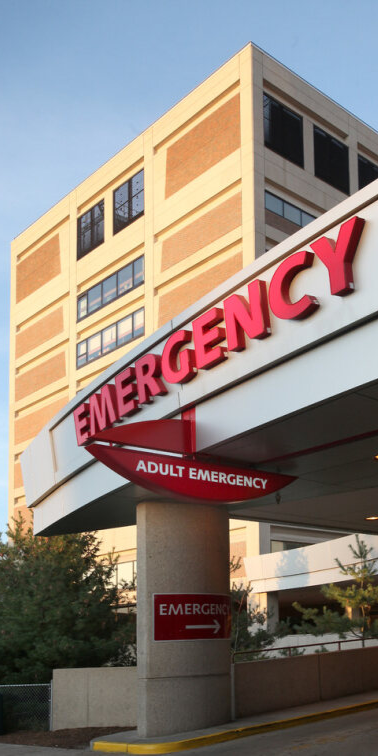Making healthcare healthier

Authored by

Beau Brockett Jr.
Over the past few decades, there’s been a marked shift in the American healthcare paradigm. So says Chip Amoe, sustainability officer for University of Michigan Health.
In the past, clinicians tended to focus on diagnosing and treating a specific condition or disease with medication and technology, he said. That’s still the case, but now clinicians are placing those ailments in the context of patients’ greater lives—where they live, how they eat, where they work, how they sleep, the money they make, the education they have.
Take lead poisoning as an example. A pediatrician may prescribe a treatment process for a sickened child, but these clinicians may also work to understand that child’s life. From there, they may discover that a child lives in an old home or drinks from old water pipes. They may then connect that child’s parents to programs that can remove lead at its source.
Now, healthcare systems are also undergoing a similar shift. Its staff are looking at how their own work environments—their buildings, their food, their equipment and their transportation—are affecting the health of the communities they serve. And institutions in Michigan are doing something about it.
Bustling cities in miniature
When we think of pollution, we think of coal smokestacks, monolith industries and traffic-clogged roads. But even our kinder construction is an unintentional culprit.
Homes account for 18% of climate-change-causing emissions in Michigan. Healthcare buildings (which we’ll refer to as hospitals for simplicity) account for 8.5% of those emissions nationally.
If you’ve been following our Project Greenprint, you’ll know what causes this pollution in homes and how folks are fixing it. But how did hospitals end up this way?
“Hospitals never stop. They’re open 24/7, 365 days,” said Kaylee Swanson, sustainability analyst for Corewell Health, one of west Michigan’s largest healthcare providers.
Traditionally, the lights are always on. Water is always running. Gloves, wristbands, needles and hundreds of other products are being ordered and used and tossed. Breakfasts, lunches, dinners, and snacks are prepared, served and eaten. Vehicles are constantly moving patients and employees. Air conditioning always keeps things clinically cool.
Hospitals, in a way, are miniature cities.
Then there is the medical equipment. In order to save and improve lives, these high-tech tools require lots of energy to function and lots of coolant to keep from overheating. For reference, Swanson said a typical hospital uses 2.5 times more energy than an average building of the same size. The operating room uses 6 times more energy.
This nonstop, high-energy environment, naturally, can create environmental problems if done without thought. Emissions from all the energy used can cause heart and lung conditions locally. These emissions also contribute to climate change, which causes more heat stroke, extreme weather and contagious diseases from insects. The production of hospital food and equipment can create chemical pollution at its sources and more waste when folks at the hospital have eaten or used them.
Fortunately, Michigan hospitals are taking collaborative action to improve the health of their patients and communities by making their hospitals sustainable.
“Healthcare’s mission is to improve the health of the communities we serve,” said Swanson of hospitals. “We don’t want to hurt our communities while we’re trying to help them as well.”
Amoe, of University of Michigan Health, put it another way.
“We can provide the best healthcare in the world between the four walls of our facilities, but if we send people home to the same unhealthy environments from which they came, they’ll be right back again.”
Creating good days everyday
When we think of pollution, we think of coal smokestacks, monolith industries and traffic-clogged roads. But even our kinder construction is an unintentional culprit. Homes account for 18% of climate-change-causing emissions in Michigan. The healthcare industry and its buildings account for 8.5% of those emissions nationally.
If you’ve been following our Project Greenprint, you’ll know what causes this pollution in homes and how folks are fixing it. But why are healthcare facilities such big contributors?
“Hospitals never stop. They’re open 24/7, 365 days,” said Kaylee Swanson, sustainability analyst for Corewell Health, one of west Michigan’s largest healthcare providers.
Traditionally, the lights are always on. Water is always running. Gloves, wristbands, syringes and hundreds of other products are being ordered and used and disposed of. Breakfasts, lunches, dinners, and snacks are prepared, served and eaten. Vehicles are constantly moving patients and employees. Heating and cooling are always running.
Then there is the medical equipment. In order to save and improve lives, these high-tech tools require lots of energy to function and lots of coolant to keep from overheating. For reference, Swanson said a typical hospital uses 2.5 times more energy than an average building of the same size. The operating room uses 6 times more energy.
Hospitals, in a way, are like miniature cities, and these sorts of nonstop, high-energy environments like these can naturally create environmental problems. Emissions from all the energy used can cause heart and lung conditions locally. These emissions also contribute to climate change, which causes more heat stroke, extreme weather and contagious diseases from insects. The production of hospital food and equipment can create chemical pollution at its sources and more waste when folks at the hospital have eaten or used them.
Fortunately, Michigan healthcare workers are taking collaborative action to improve the health of their patients and communities by making their facilities sustainable.
“Healthcare’s mission is to improve the health of the communities we serve,” said Swanson of hospitals. “We don’t want to hurt our communities while we’re trying to help them as well.”
Amoe, of University of Michigan Health, put it another way.
“If hospitals can greatly improve their own environmental footprint and demonstrate to others how to make healthy, more sustainable choices, they can help make their communities’ environments—and thus people themselves—healthier.”
Creating good days everyday
Corewell and University of Michigan Health’s approach to improving their communities has been similar. They have brought all sorts of staff members together into collaborative groups, each tackling a unique aspect of sustainable healthcare.
Here’s a hypothetical. When trying to reduce food waste and emissions, supply chain staff may know which foods use less energy to produce and ship. Food service workers may know which foods people like best. Clinicians may know which foods are healthiest. And custodians may know which food scraps produce less waste.
“I think it’s always good to have different perspectives at the table,” said Amoe. “We’re not just approaching this from a sustainability, administrative or clinical perspective. We’re taking a wholistic approach to create win, win, win scenarios for our patients, our planet and our own operations.”
Both Swanson and Amoe highlighted the sustainable anesthesia workgroups of Corewell and U-M Health as exemplars of this collaborative practice. Each has helped greatly reduce harmful emissions. The switch to a ‘green’ approach even helped save hundreds of thousands of dollars.”
“When physicians are involved in a goal, things get done,” said Swanson.
The trouble is getting healthcare staff involved in the first place—they are often stressed and busy, said Lauren Church. If they do have the time, they may not know where to start or how to organize. That’s where her organization, Michigan Clinicians for Climate Action (MiCCA), a Michigan Environmental Council member organization, comes in.
As MiCCA’s director of policy and development, Church works to provide healthcare workers the logistics, research, resources, and macro-level knowledge needed to form sustainability workgroups within their systems without feeling siloed, overwhelmed or unsure.
This is the Climate Smart Healthcare campaign, which Church recently launched. It’s a support structure for healthcare sustainability groups. It also brings groups from across healthcare systems together to learn from one another and to work toward larger goals.
That includes advocacy at Michigan’s Capitol for stronger climate laws or advocacy at United States Department of Health & Human Services to set stronger rules around hospital pollution.
Through these efforts, Church, Amoe and Swanson hope healthcare systems can make patients’ environments safe, secure and healthy. It’s preventative care in a not-so traditional way.
This vision for the future can be rendered down to how Church said her mom, an occupational therapist, describes her feelings about work. On a good day, she feels like her patients can leave the hospital and have what they need to be healthy. On bad days, she feels that her patients don’t. Church wants lots of good days.
Discover
Power environmental change today.
Your gift to the Michigan Environmental Council is a powerful investment in the air we breathe, our water and the places we love.
Sign up for environmental news & stories.
"*" indicates required fields





